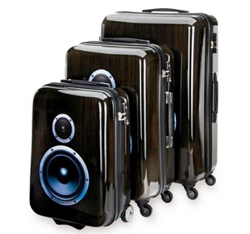
Document, Document, Document
Develop input lists, cue sheets, packing lists and inventory sheets. Make sure every thing is spelled out. Even though our set up doesn’t vary much from week to week, I make an input list anyway.
We use Google Docs to post it online where our entire team can view it. It’s easy to update and even new volunteers can follow the patching. We use cue sheets to organize our service, and set up and take down checklists to make sure everything happens the right way each week.
It might seem like it gets old hat, but there will (hopefully) come a day when you are adding new people to the team, and a checklist or input sheet make it much easier to train them.
Don’t Skimp On Cases
I’ve seen churches (and some bands) try to do pack their entire audio system into a bunch of Rubbermaid bins they bought at Walmart. Now, I love Rubbermaid bins as much as the next guy, but they are not the right way to transport thousands of dollars of A/V gear.
Cases that the gear fits into properly are not a luxury. If your cases are designed correctly, they will fit in the back of the truck or trailer evenly and fully, will stack better and be easier to load in and load out. Use wheels. Nothing tires people out faster than carrying hundreds of pounds of equipment in each week. Roll it.
Organize things into cases by where it’s used. Don’t put mics and the CD player in the same case. If you do, you create unnecessary footsteps. I’ve seen some churches very successfully build their own cases for durable things like light poles and mic stands. But for the expensive stuff, have a case built. Your gear will last longer and not fail you when you can least afford it.
Develop Teams
It’s tough getting to church at 6:30 am, loading equipment in, setting it up, doing church, then reversing the process. Doing it every week is a recipe for burnout. You need to enough people for at least two teams to do the job. Three would be even better.
It means more people to train and organize, but in the long run, you’ll go through fewer people. And when one person does leave, it doesn’t shut the whole program down. I would make this a priority if I were in Christie’s shoes (which come to think of it, I will be in a few weeks…).
Right now we have two teams of four each for presentation and lights. That means each person is on once per month. We have two FOH engineers and two guys for audio set up that we’ll be training to engineer as well. My goal is to have four engineers and four audio set up guys. This keeps everyone fresh, yet gives them enough time on the job to get good at it.
So there you go. Like I said at the outset, I’m no expert on doing portable church. However, the same principles that make a touring concert production run smoothly apply to moving a church in and out. We have to adapt for volunteers, but over time, I think we can develop systems that would make the best roadies envious.
Mike Sessler is the Technical Director at Coast Hills Community Church in Aliso Viejo, CA. He has been involved in live production for over 20 years and is the author of the blog, Church Tech Arts . He also hosts a weekly podcast called Church Tech Weekly on the TechArtsNetwork.
